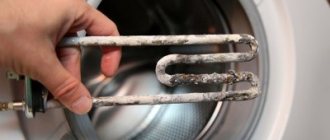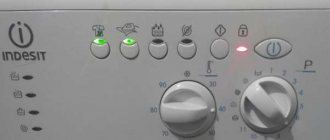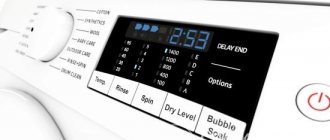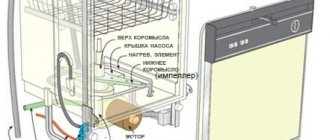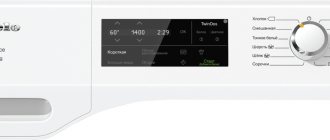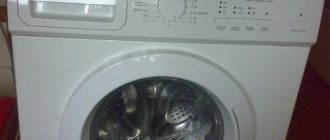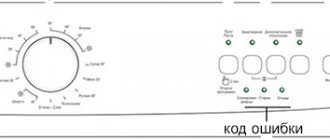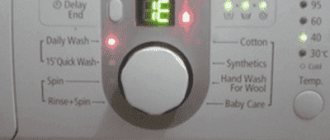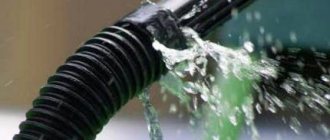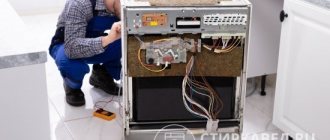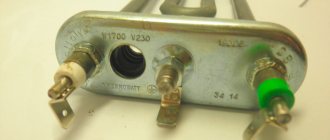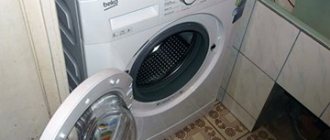Deciphering error codes on Beko washing machines
Beko washing machines come in two types: with and without display. On equipment equipped with a screen, the code looks like a combination of letters and numbers. Simpler devices indicate the type of failure by lighting certain LEDs. If the error appears for the first time, it may not indicate a malfunction, but a failure due to a voltage drop. You need to unplug the Beko washing machine from the socket, leave the appliance for fifteen to twenty minutes, and then plug it back in and try to start it. If the error appears again, you need to start deciphering the code.
In inexpensive models, this error code corresponds to the first LED that lights up (from left to right). It notifies you that the temperature sensor is faulty, so the water in the washing machine does not heat up or, conversely, reaches higher temperatures than set by the program. It is necessary to inspect the sensor, check the condition of its contacts, and test it with a multimeter. If it is faulty, it will need to be replaced.
On simple models of Beko washing machines, the second indicator on the left lights up. Notifies that the heating element is damaged. Linen is washed in cold water and remains dirty. It is necessary to disassemble the device to gain access to the heating element, turn off the power, ring with a multimeter and make sure that the readings on the display are from 20 to 30 ohms. This means that the part is working properly, and the user should check the condition of the wiring going from the heating element to the control unit. Any damaged chain links will need to be repaired.
The first and second LEDs on the left are lit. The heating element works without turning off, as a result the liquid overheats. It is necessary to ring the temperature sensor responsible for the water heating temperature. Next, you will need to diagnose the system board and check the triac that controls the thermistor.
This error code corresponds to a continuous light on the third LED from the left on Beko machines without a display. The triac that controls the liquid fill valve is damaged. You should inspect the wiring going to the module and check the contacts. If traces of burning are found, the damaged link must be replaced. If defects are found on the control module, it should be replaced with a working one or contact a service center for repair.
On simple models, this code is determined by the glow of the first and third indicators. This message indicates that the drain pump is damaged or there is a blockage in the system. You should sequentially clean the liquid drain filter and the pipe, then inspect the hose, make sure that there are no blockages in it, and that it is not kinked or pinched by foreign objects. The last thing you need to do is remove the pump, inspect it, remove blockages if there are any, check the impeller, remove any wound wool, threads and hair. If all these steps do not bring results, you need to install a new drain pump.
Error code H6 or continuous lighting of the second and third LEDs indicate problems with motor control. It is necessary to diagnose the triac on the system board that controls the operation of the motor. If this unit is working properly, you need to inspect the wiring for breaks and contacts, make sure that there is no damage or traces of burning. Next, you will need to diagnose the motor itself. Faulty elements will need to be replaced with working ones.
The constant lighting of the first, second and third indicators and error code H7 indicate that the operation of the pressure switch (liquid level sensor) is impaired. You need to check how tightly the door closes and if there are problems, replace the hatch locking device. Next, you need to make sure that there is water in the tap and the pressure is sufficient for the Beko machine to operate. You should also check the valve at the inlet of the device and make sure it is open. After this, you will need to diagnose the pressure switch and the wires from the sensor to the system board. The inlet valve needs to be ringed. All faulty components should be replaced with new ones.
This error and the continuous lighting of the third and fourth LEDs indicate a lack of communication with the engine. To troubleshoot the problem, you need to check the wiring from the motor to the system board, the control unit, the tachometer and the engine itself.
Content
- Control module "FORA"
- Control module "JUMP"
- Control module "7S"
- Control module "N7S"
- Mini LCD control module
Explanation of the designations of VEKO washing machines.
| Position | Meaning | A comment |
| 1st block of letters | ||
| 1 | W (washing machine) - washing machine | |
| 2 | Place of production |
|
| 3 | Type of shell |
|
| Block of numbers | ||
| 1 | Series of models (differ by electronic control module) |
|
| 2 (or 2, 3)³ | Loading dry laundry (in kg) | 5 kg, 6 kg, 7 kg (or 3.5 kg, 4.5 kg) |
| 4 (or 3.4) | Maximum drum rotation speed during spinning (x 100 rpm) |
|
| 5 | Type of dynamic system (design of tank, drum, drive, shock absorbers) |
|
| 2nd block of letters | ||
| 1 | Firmware type for control module⁴ |
|
| 2 | Case color |
|
- “²” – washing machines of the “Fora” series designed for a load of 4.5 kg of laundry (WKE 14580D, WKL 14580D) – are equipped with the next generation control module: “Jump”.
- “³” - the third digit in the notation system, as can be seen from the table, has a variable purpose. In machines with a load of dry laundry indicated with tenths (3.5 kg, 4.5 kg) - this is the number after the decimal point. In other cases, this is the first digit in the designation of the maximum rotation speed of the drum during spinning.
- “⁴” — The control module firmware determines the washing and spin class. For the “Fora” series: K, KV – low indicators; D,DB – average; R, RV – high. For the “Jump” series: R – low (no spin speed control), T – medium and high.
Control module (electronic controller) – from 2100 rubles*
The control unit is a microcircuit that contains the entire operating algorithm of the washing machine. Due to voltage surges or moisture ingress, individual radio elements and/or tracks burn out. Also, due to unstable voltage in the electrical network, the firmware crashes.
SIGNS
If the control module malfunctions, the Beko machine can produce a wide variety of malfunctions: it does not fill or drain water, it does not start washing or suddenly interrupts it, it does not spin the drum or does not turn on at all. The breakdown may be accompanied by errors H2, H3, H4, H5, H6, H7 or H11.
HOW TO FIX
The technician diagnoses the board by ringing radio elements and tracks. The burnt elements (triacs, relays, resistors, etc.) are replaced with new ones, and the tracks are soldered. If a firmware failure is detected, the technician unsolders the memory chip, reprograms it and returns it to its place.
If the module is severely damaged, in particular, the processor fails, it is advisable to replace the board with a new one.
*Rates are only for the work of the master; new elements or modules are paid separately.
When to do repairs yourself?
Experts advise users to carry out on their own only the simplest repair work that does not require special knowledge, namely:
It is better to entrust all other cases to professionals, so as not to damage the washer even more. Typical cases that you can handle yourself:
Different models of SMA Veko have not only similar structures and characteristics, but also the same problems. In a Beko machine for 5 kg, the faults will be the same as in a device designed for 3 kg. Timely familiarization with the instructions and compliance with operating rules will help prevent problems.
What causes Beko air conditioner breakdowns?
Beko air conditioners can be found in offices, apartments, and cottages. These are affordable and high-quality split systems or floor-mounted mobile units. Thanks to their practicality, functionality and reliability, air conditioners of this brand work properly without breakdowns in the most difficult conditions.
However, over time, especially with heavy use, your Beko air conditioner may break down. This can manifest itself not only by turning off the device and the appearance of an error code on the display, but also trivially: the unit will begin to leak, the cooling flow will weaken, and ice will appear.
Both the external and internal units of Beko air conditioners are constantly exposed to external influences. Most of them adversely affect the operation of climate control equipment
Main causes of breakdowns:
After repairing the equipment, be sure to study the instructions for routine maintenance of the air conditioner.
Some features to consider
The equipment from Beko is very conveniently designed, so replacing the same worn bearing is not difficult. Also, these machines are much easier to disassemble than equipment from other manufacturers. During repairs, most often you will not need to remove the tank; the components will already be available. You can only remove its front part, after which it will be possible to get the drum from the back, but the tank will still remain in the machine. Only if the bearing has completely become unusable and needs to be removed from the glass, you will have to remove the drum along with the tank.
To gain access to the front of the tank, you first need to remove the front panel and lower counterweight. Afterwards, you need to unscrew the tubes and wires from the tank. Before you disconnect all this, take a photo, especially of the soldered wires. By doing this, you can be sure of correct assembly.
The tank is secured at the front with 12 clips; they need to be removed. After which it can easily be pulled out. The bearings are seated very tightly on it, so it must be carefully knocked out, preferably with a rubber drum.
The screw that held the pulley to the shaft should not be used again.
The user will immediately find out that the bearing in the automatic machine has worn out or completely fallen apart. The washing machine will begin to make a “knocking” sound, hum, vibrate and malfunction. To prevent the unit from permanently failing, it is necessary to replace the drum bearing as soon as possible. Timely repairs will preserve the remaining elements and components of the system.
Conclusions and useful video on the topic
Watch the video that explains in detail how to properly clean your air conditioner:
The ability to detect breakdowns at an early stage will extend the life of the air conditioner. Problems caused by insufficient care of the unit can be solved independently. If the breakdown is caused by defective parts and components, it is better to call a specialist. Knowing the error codes and diagnostic sequence will help you quickly navigate this issue.
Would you like to talk about how you determined the air conditioner problem using the error code? Do you have useful information on the topic of the article? Please leave comments in the block below, post photos and ask questions.
What are the features of the renovation?
Models from Beko have design advantages that are especially useful when replacing bearings:
What other features of disassembly:
Advice. Before disconnecting the wires, fix the original position in the photo - this will help you later when you assemble the device.
The screw connection holding the pulley on the drum shaft must not be removed.
Error coding principle
Let's look at how to find the cause of a problem with Beko air conditioners using the error code. Let's look at what combinations of letters and numbers can appear on the display of various devices.
If an error appears on the display, you must immediately respond to the signals from the diagnostic system and decide whether to correct the situation yourself or whether it is better to call a mechanic to repair climate control equipment
For air conditioners types BKL INV, BKC INV:
| Error code | Decoding |
| E1 | There is a problem with the temperature sensor in the indoor module |
| E2 | Problems with the evaporator temperature sensor |
| E3 | Errors in compressor operation |
| E5 | The connection between the outdoor and indoor modules is broken |
| 1E | Defect in the operation of the outside air temperature sensor |
| 2E | Condenser temperature sensor problem |
For air conditioners types BKH, AKP, AKH, BS, BKP, AS:
| Air conditioner error | Decoding |
| FF03 | Overheating of the condenser operating in the “cold” mode is observed |
| FF04 | Overheating of the condenser operating in the “heat” mode is observed |
| FF06 | Problems with the fan in the indoor module |
| FF07 | Room temperature sensor does not work |
| FF08 | Problems with the operation of the evaporator temperature sensor |
| FF09 | Problem with the operation of the capacitor temperature sensor |
Error codes for BKN and AKN air conditioners:
| Error | Ind. RANNING | Ind. SLEEPING | Ind. TIMER |
| Having problems with the internal solenoid type temperature sensor | Starts to blink | Starts to blink | Starts to blink |
| A room temperature sensor defect is diagnosed | Starts to blink | Starts to blink | Shining |
| Having problems with the external solenoid type temperature sensor | Starts to blink | Starts to blink | Doesn't light up or blink |
| The fan motor in the indoor module is faulty | Starts to blink | Shining | Starts to blink |
Using the above tables, you can determine the cause of the breakdown of the air conditioner and split system. In almost all cases, the climate system turns itself off.
A number of problems can be “cured” on your own: especially if they are related to replacing filters and clearing blockages. It is important to know which code indicates errors that you can fix yourself
You need to start diagnosing an air conditioner by analyzing the most common breakdowns.
Typical malfunctions of Beko washing machines
By entrusting the inspection of your car to an experienced technician, you can rest assured that he will quickly and professionally find what the problem is. But due to the high prices for services, many home craftsmen are trying to save money and repair the Beko washing machine themselves.
Almost any SMA model can be repaired at home: ELB 57001 M, RKB 58801 MA, LNU 68801, etc.
This approach is quite justified - often repairs are exorbitantly expensive, and sometimes the price is such that you can buy a new machine. At the same time, even the most “killed” car can last for several more years after repair.
Don't want to throw away your Veko machine and buy a new one? Try to figure out the problem yourself and fix everything yourself.
The design of the Beko washing machine also determines the nature of its breakdowns. Let's look at typical malfunctions of washing machines of this brand:
Important! There may be other signs of failure. We looked at the most common ones among Beko SM users in Russia.
Deciphering error codes on Beko washing machines
Beko washing machines come in two types: with and without display. On equipment equipped with a screen, the code looks like a combination of letters and numbers. Simpler devices indicate the type of failure by lighting certain LEDs. If the error appears for the first time, it may not indicate a malfunction, but a failure due to a voltage drop. You need to unplug the Beko washing machine from the socket, leave the appliance for fifteen to twenty minutes, and then plug it back in and try to start it. If the error appears again, you need to start deciphering the code.
In inexpensive models, this error code corresponds to the first LED that lights up (from left to right). It notifies you that the temperature sensor is faulty, so the water in the washing machine does not heat up or, conversely, reaches higher temperatures than set by the program. It is necessary to inspect the sensor, check the condition of its contacts, and test it with a multimeter. If it is faulty, it will need to be replaced.
On simple models of Beko washing machines, the second indicator on the left lights up. Notifies that the heating element is damaged. Linen is washed in cold water and remains dirty. It is necessary to disassemble the device to gain access to the heating element, turn off the power, ring with a multimeter and make sure that the readings on the display are from 20 to 30 ohms. This means that the part is working properly, and the user should check the condition of the wiring going from the heating element to the control unit. Any damaged chain links will need to be repaired.
The first and second LEDs on the left are lit. The heating element works without turning off, as a result the liquid overheats. It is necessary to ring the temperature sensor responsible for the water heating temperature. Next, you will need to diagnose the system board and check the triac that controls the thermistor.
This error code corresponds to a continuous light on the third LED from the left on Beko machines without a display. The triac that controls the liquid fill valve is damaged. You should inspect the wiring going to the module and check the contacts. If traces of burning are found, the damaged link must be replaced. If defects are found on the control module, it should be replaced with a working one or contact a service center for repair.
On simple models, this code is determined by the glow of the first and third indicators. This message indicates that the drain pump is damaged or there is a blockage in the system. You should sequentially clean the liquid drain filter and the pipe, then inspect the hose, make sure that there are no blockages in it, and that it is not kinked or pinched by foreign objects. The last thing you need to do is remove the pump, inspect it, remove blockages if there are any, check the impeller, remove any wound wool, threads and hair. If all these steps do not bring results, you need to install a new drain pump.
Error code H6 or continuous lighting of the second and third LEDs indicate problems with motor control. It is necessary to diagnose the triac on the system board that controls the operation of the motor. If this unit is working properly, you need to inspect the wiring for breaks and contacts, make sure that there is no damage or traces of burning. Next, you will need to diagnose the motor itself. Faulty elements will need to be replaced with working ones.
The constant lighting of the first, second and third indicators and error code H7 indicate that the operation of the pressure switch (liquid level sensor) is impaired. You need to check how tightly the door closes and if there are problems, replace the hatch locking device. Next, you need to make sure that there is water in the tap and the pressure is sufficient for the Beko machine to operate. You should also check the valve at the inlet of the device and make sure it is open. After this, you will need to diagnose the pressure switch and the wires from the sensor to the system board. The inlet valve needs to be ringed. All faulty components should be replaced with new ones.
This error and the continuous lighting of the third and fourth LEDs indicate a lack of communication with the engine. To troubleshoot the problem, you need to check the wiring from the motor to the system board, the control unit, the tachometer and the engine itself.
Cleaning the drain
In the SMA, dirty fluid is passed through a drain filter, which prevents hair, threads and dirt particles from entering the pump. The user's task is to clean the filter. But first you have to find him. As a rule, it is located at the bottom of the device. Before removing the filter, place a basin nearby or place a rag so that water gushing out of the hole does not spread across the floor.
In some Beko models, the filter is supplemented with an emergency hose for convenient drainage of liquid. How to clean a drain:
Problems with Beko air conditioners
Let's look at what malfunctions of the Beko air conditioner owners most often encounter, and carefully consider how to fix it.
If the air conditioner does not cool
There are several reasons why an air conditioner stops cooling. Our list ranks them from most likely to least likely.
To identify the cause of a breakdown, you need to test each cause, starting with the first:
Some parts can be repaired. In case of some breakdowns, units and components that cause the split system to cool poorly cannot be restored and will have to be replaced.
How to set up climate control equipment for cooling is described in detail in our recommended article.
Fan doesn't work
If the fan stops working, check it for the following faults, starting with the most common:
All errors can be generated by a damaged control board. Naturally, in this case there must be a replacement.
Also, the reason the fan stops may lie in a malfunction of the thermistor, capacitor, or rotary switch. If the cause of the failure is the fan motor, it will have to be replaced. Worn out or burnt out fan motors cannot be repaired.
Compressor does not work
If the compressor stops working, you should check:
Even more rare causes of compressor inoperability are problems with the thermistor, breakdown of the relay board, or a defect in the main control board. The capacitor may burn out.
Correct installation of climate control equipment is very important to prevent breakdowns. You must not violate the manufacturer’s recommendations set out in the instructions for the device. Be sure to observe the height and distance between blocks specified in the technical documents
If the equipment was installed unevenly, the drains will become clogged first, and then the engine and radiator will break.
Why is the air conditioner so noisy?
The split system can operate noisily, and no error will be displayed on the display. In this situation, it is important to react in time and find the causes of the noise. Otherwise, the breakdown may worsen and lead to failure of the climate control equipment.
What could be the reasons for noisy operation:
A noisy air conditioner, of course, creates certain inconveniences during operation, but this does not mean that you need to immediately change spare parts. First you need to find out the cause of the noise; perhaps it is not so serious.
Water is leaking from the indoor unit or floor unit
If a puddle collects under the indoor module, there may be several reasons:
Regular cleaning of the drainage pipeline is specified in the instructions for use.
The air conditioner drain pipe should be cleaned a couple of times a year during heavy use.
After the split system is installed correctly, nothing should drip from anywhere, unless this is a feature of the drainage system.
Fighting heat exchanger freezing
A freezing heat exchanger is a fairly common problem, which most often occurs due to lack of regular cleaning or replacement of the air filter. If it is clogged, the air flow through the evaporator coils is reduced.
The evaporator coils cool and moisture condenses on the coils, gradually freezing. This causes the evaporator coil assembly to freeze. Solving the problem - replacing the air filter
Maintenance of the air conditioner must be carried out regularly in accordance with the requirements of the accompanying instructions.
Removing damaged bearings
To get to the drum and bearings, you need to deal with the “back”. If the upper part of the tank can be easily and quickly removed after cutting, then you will have to work longer with the lower half. The first step is to loosen the nut securing the drum pulley. Then we proceed like this:
WD-40 will help deal with stuck parts.
By removing the second half of the tank, you can finally gain access to the drum. We need bearings that are on the shaft. To remove the ball rings, just use a car puller . In the absence of the latter, we resort to the help of car mechanics or arm ourselves with a hammer and chisel.
Afterwards all that remains is to knock out the old bearings and install new ones in their place. Having completed the replacement, we put Beko back together. First, we connect the two halves of the tank together with bolts and sealant, then we return the drum to the washing machine body, and then the rest of the components. We will not describe the assembly process in detail - we follow the above instructions, only in reverse order.
Interesting:
Preventive measures
To ensure that your Beko washing machine breaks down as little as possible, it requires regular preventive maintenance.
- On average, once every 6 months, and then depending on how often the washing machine is used, you need to clean the drain filter from accumulated dirt, and also wash the mesh at the inlet.
- The washing machine must be connected to the network through a voltage stabilizer. It is able to save electronics from unexpected voltage drops.
- A cleaning filter must be installed at the entrance to the washing machine. This will reduce scale deposits and extend the life of the heating element.
- Electronics are one of the weakest points of Beko and other brands of machines, so it is better to install the equipment in a dry room to avoid corrosion and liquid getting on the system board.
Self-diagnosis system base
It usually happens that the operating instructions for the washing machine have been lost for a long time, and it is necessary to deal with the malfunction as soon as possible. Below is a list of the main errors found in the washing machine database. For the convenience of users, we will indicate not only the alphanumeric designation, but also the sequence of indicator lights.
! It is better to invite a repairman to repair or replace the control board.
Knowing which element of the system has failed, it is easy to make repairs yourself. Having understood the designation of certain breakdowns, it is easy to understand what actions should be taken to return the washing machine to its previous performance.
